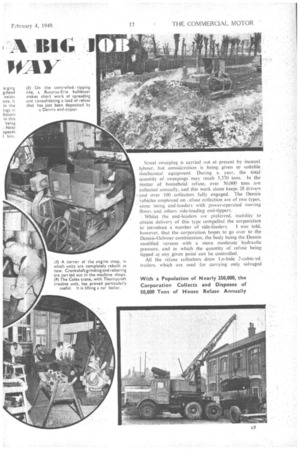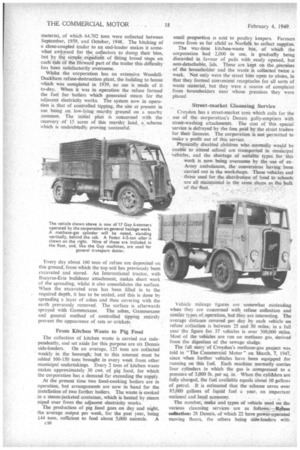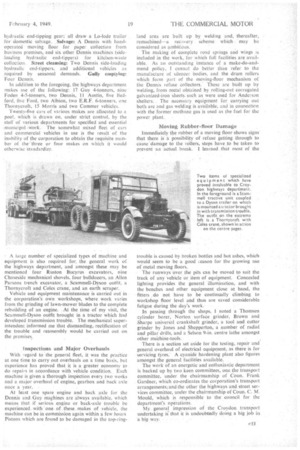40 OAT DI 7NAlt
Page 16

Page 17

Page 18

Page 19

If you've noticed an error in this article please click here to report it so we can fix it.
IT will not be generally known that the first public railway in the world ran from Croydon (Surrey) to Wandsworth. Horse-drawn trucks were used and only goods were carried. That was in 1801, when the population was about 6,000. 'To-day the county borough of Croydon, which embraces Thornton Heath, Norbury, Upper and South Norwood, Addington, Shirley, Addiscombe, Warldon, etc.,. has to minister to the welfare of nearly 250.000 people.
The motto on the corporation's coat of arms. "Sanitate Crescarnus 7 (let -us grow in health), is particularly apt, because Croydon prides itself on its health services, of which refuse -collection and street cleansing are important parts. Some idea of the task which Mr. C. E. Boast, 0.B.., MC., M.Inst.C.E., F.R.I.C.S., borough engineer, and his staff have to tackle may be gained from the fact' that there are 23-5-miles of highway in the borough, refuse has to be collected from over 70,000 premises, and 18,000 street gullies have to he cleaned at regular intervals. Street sweeping is carried out at present by manual labour, but consideration is being given to suitable
mechanical equipment. During a year, the totaliiantity of -sweepings may reach 5,370 ton's. In the matter of household refuse, over 50,000 tons are icollected annually, and this work alone keeps 28 drivers -'..and over 100 collectors fully engaged. The Dennis • "i/ehicles employed on .-efuse collection are of two types, some being end-loaders with power-operated moving floors and others side-loading end-tippers.
Whilst the end-loaders are preferred, inability to obtain delivery of this type cornpetled the corporation to introduce a number of side-loaders. I was told, however, that the corporation hopes to go over to the Dcnnis-Ochsner combination; the body being the Dennis modified version with a more moderate hydraulic pressure, and in which the quantity of ,refuse being tipped at any given point can be controlled.
All the refuse collectors draw Lo-lode 2-cubic-yd. trailers, which are used for carrying only salvaged
material, of which 64,702 tons were collected between September, 1939, and October, 1948. The hitching of a close-coupled trailer to an end-loader makes it somewhat awkward for the collectors to dump their bins, but by the' eipedietit of fitting broad steps on each Side of the forward part of the trailer this difficulty has been satisfactorily overcome.
Whilst the corporation has an extensive WoodallDuc.kham refuse-destruction plant, the building to house which was completed in 1939, no use is made of it to-day. When it was in operation the refuse formed the fuel forboilers which generated steam for the adjacent electricity works. The system now in operation is that of controlled tipping, the site at present in use being on low-lying marshy ground on a nearby common. The initial plan is concerned with the recovery of 15 acres of this marshy land,, a scheme which is undoubtedly proving successful.
Every day about 160 tons of refuse are deposited on this ground, from which the top soil has previously been excavated and stored. An International tractor, with Bucyrus-Erie bulldozer attachment, makes short work of the spreading, whilst it also consolidates the surface. When the excavated area has been filled in to the required depth, it has to be sealed, and this is done by spreading a layer of ashes and then covering with the earth previously removed. The surface is afterwards sprayed with Gammexane. The ashes, Garrimexane and general method of controlled tipping entirely prevent the appearance of rats or crickets.
From Kitchen Waste to Pig Food
The collection of kitchen waste is carried out independently, and set aside for this purpose are six Dennis side-loaders. On an average, 125 tons are collected weekly in the borough, but to this amount must be added 100-150 tons brought in every week from other municipal undertakings. Every 2 tons of kitchen waste makes approximately 30 cwt. of pig food, for which the corporation has a demand far exceeding the supply.
At the present time two food-cooking boilers are in operation, but arrangements are now in hand for the installation of two further boilers. The waste is cooked in a steam-jacketed container, which is heated by steam
piped oNcer from the adjacent electricity works. . The producticrn of pig food goes on day and night, the average output per week, for the past year, being 144 tons, sufficient to feed about 5000 animals. A c1t) small proportion is sold to poultry keepers. Farmers come from as far afield as Norfolk to collect supplies.
The war-time kitchen-waste bin, of which the corporation bad 2,000 in use, is gradually being discarded in favour of pails with easily opened, but non-detachable, lids. These are kept cm the,premises of the householder and the waste is collected twice a week. Not only were the street bins open to abuse, in that they formed convenient receptacles for all sorts of waste material, but they were a source of complaint from householders near whose premises they were placed.
• Street-market Cleansing Service
Croydon has a street-market area which calls for the use of the corporation's Dennis gully-emptiers with street-washing attachments. The cost of this special service is defrayed by the fees paid by the street traders for their licences. The corporation is not permitted to make a profit out of this service.
Physically disabled children who normally would be unable to attend school are transported in municipal vehicles, and the shortage of suitable types for this work is now being overcome by the use of exArmy ambulances, the conversions having been carried out in the workshops. These vehicles and those used for the distribution of food to schools are all maintained in the same shops as the bulk of the fleet.
Vehicle mileage figures are somewhat misleading when they are concerned with refuse collection and similar types of operation, but they are interesting. The average distance covered per day by each vehicle on refuse collection is between 25 and 30 miles; in a full year •the figure for 37 vehicles is over 300,000 miles. Most of the vehicles are run on methane gas, derived from the digestion of the sewage sludge.
The full story of Croydon's methane-gas project was told in "The Commercial Motor" on March, 7, 1947, since when further vehicles have been equipped for running on this fuel. Each machine normally carries four cyginders in which the gas is compressed to a pressure of 3,000 lb. per sq. in. When the cylifiders are fully charged, the fuel available equals about 10 gallons of petrol. It is estimated that the scheme saves over 85,000 gallons of liquid fuel a year, an important national and local economy.
The number, make and types of vehicle used on the various cleansing services are as follows:—,-Refnse collection: 28 Dennis, of which 22 have poWer-operated moving floors, the others being side-loaders with hydraulic end-tipping gear:. all draw a Lo-lode trailer for domestic Salvage... ...Salvage:. A Dennis with handoperated —movingfloor for paper collection from business premises, and six other Dennis machines (sideloading hydraulic end-tippers) for kitchen-waste collection.. Street cleansing: Two Dennis side-loading hydraulicend-tippers, and additional vehicles as .required by seasonal demands. Gully emptying: Four Dennis.
In addition to the foregoing, the highways department makes use of the following: 17• Guy 4-tonners, nine Foden 4-5-tormers, two Dennis, 11 Austin, five Redford, five Ford, two Albion, two E.R.F. 6-tonners, one Thornycroft, 15 Morris and .two Commer vehicles.
Twenty-five cars of various. makes are allocated to a pool, which •ls .drawn on, under strict control, by the staff of various 'departments for specified and essential :municipal ,Work.• The -somewhat mixed fleet of cars and commercial vehicles in use is the result of the inability of the corporation to obtain the requisite number Of the three or four makes on which if would otherwise standardize.
• A large number of specialized types of machine and equipment is also required ..for, the general work of the highwaysdepartment, and amongst these may be mentioned four Ruston Bucyrlis excavators, nine Chaseside mechanical shovels, four bulldozers, an Allen Parsons trench excavator, a Scamrnell-Dyson outfit, a Thornycroft and Coles crane, and an earth scraper.
Vehicle and equipment maintenance is carried out in • the corporation's own workshops, where work varies from the grinding of lawn-mower blades to the complete rebuilding of an engine. . At the time of' my visit, the Scarnmell-Dysian outfit brought in a tractor which had developed transmission trouble. The mechanical superintendent informed me that dismantling, rectification of the trouble and reassembly would be carried out on the premises.
Inspections and Major Overhauls
With regard to the general fleet, it was the practice at one time to carry out overhauls on a time basis, but experience has proved that it is a greater economy to do repairs in accordance with vehicle condition.. Each machine is given a thorough inspection every two weeks and a major overhaul of engine, gearbox and back axle once a year.
At least one spare engine and back .axle for the Dennis and.Guy rnaohines are always available, which means that if serious .e.ngine or back-axle trouble be experieneed., with: one of these., makes of :vehicle, the . machine can be in commission again within a few hours Pistons which are,fotincl to be damaged in the top-ring
land area arc built up by welding. and, thereafter, remachined--a rec:wery scherne whichmay be considered as ambitious. .
The making of complete road springs and wings is included in the work, for which full facilities are available. As an outstanding instance of a make-do-andmend policy, I cannot do better than refer to the manufacture of silencer bodies, and the drum rollers which form part• of the moving-floor mechanism of the Dennis refuse collectors. These are bbilt up by welding, from metal obtained by rolling-out corrugated galvanized-iron sheets, such as were used for Anderson shelters. The necessary equipment for carrying out both arc and gas welding is available, and in connection with the former methane gas is used as the fuel for the power plant.
MOving Rubber-floor Damage
Immediately the rubber of a Moving floor shows signs' that there is a possibility, of refuse getting through to cause:damage to the rollers, steps have to be taken to prevent ad actual, break. ..I learned that most of the trouble is caused by broken bottles and hot ashes, which would seem to be a good reason for the growing use of metal moving floors.
The runways over the pits can be moved to suit the track of any vehicle or item of equipment. Concealed lighting provides the general illumination, and with the benches and other equipment close at hand, the fitters .do not have to be continually climbing to workshop floor level and thus are saved considerable fatigue during the day's work.
In passing through the shops, I noted a Thomsen cylinder borer, Norton surface grinder, Brown and Sharpe univeral crankshaft grinder, a tool and cutter grinder by Jones and Shepperton, a number of radial and pillar drills, and a Selson 9-in. centre lathe amongst other maChine-tools.
• There is a section set aside for the testing, repair and general overhaul of electrical equipment, as there is for servicing tyres.' A cyanide hardening plant also figures amongst the general facilities available.
The work of an energetic and enthusiastic department is backed up by two keen committees, one the transport committee, under the chairmanship of Court. Frank Gardner, which co-ordinates the corporation's transport arrangements; and the other the highways and street services committee, under the chairmanship of Coun. C. M. Mould, which is responsible to the council for the department's operations.
My general irnpression of the Croydon transport undertaking is that it is undoubtedly doing a big job in 'a big way


























